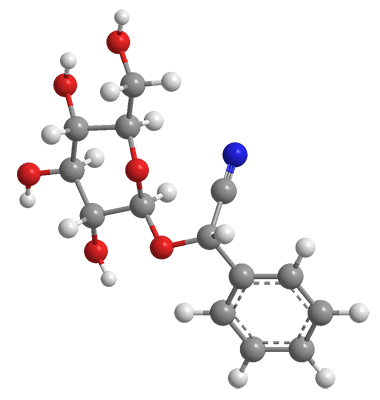What molecule am I?


Sambunigrin, also referred to as (S)-prunasin, is a cyanogenic glycoside that is produced in the leaves and other parts of the elderberry plant Sambucus nigra. Its diastereomer (R)-prunasin is found in some species of Prunus trees, including P. japonica (Japanese bush cherry) and P. serotina (wild black cherry).
In 1905, working independently, prominent French researchers—pharmacist/botanist Jean Louis Léon Guignard at the Faculty of Sciences of Lyon and chemist/pharmacist Émile Bourquelot at Laënnec Hospital in Paris—isolated sambunigrin from S. nigra leaves. They also showed that, upon enzymatic degradation, as much as 126 mg of hydrogen cyanide (HCN) is produced from 1 kg of fresh leaves. (See also the hazard information box.)
The good news about S. nigra is that its flowers and ripe berries do not contain sambunigrin. Extracts from the fruit are contained in a wide range of over-the-counter products that purport to support the immune system, help relieve cold symptoms, and combat some Gram-positive and Gram-negative bacteria. But none of these uses has yet been approved by the US Food and Drug Administration. In 2011, the FDA took legal action against a Kansas company that claimed that its elderberry juice product prevented certain illnesses and could be used to treat certain diseases.
Sambunigrin hazard information
| GHS classification*: not a dangerous substance or mixture |
*Globally Harmonized System of Classification and Labeling of Chemicals. Despite this classification in at least one safety data sheet, many reports indicate that when plant parts that contain sambunigrin are ingested, the compound hydrolyzes to HCN in the gut, making sambunigrin hazardous if it is swallowed.
Sambunigrin fast facts
| CAS Reg. No. | 99-19-4 |
| Empirical formula | C14H17NO6 |
| Molar mass | 295.29 g/mol |
| Appearance | White powder |
| Melting point | 151–152 ºC |
| Water solubility | 28 g/L (est.) |

Learn more about this molecule from CAS, the most authoritative and comprehensive source for chemical information.
Molecule of the Week needs your suggestions!
If your favorite molecule is not in our archive, please send us a message. The molecule can be notable for its current or historical importance or for any quirky reason. Thank you!
Stay Ahead of the Chemistry Curve
Learn how ACS can help you stay ahead in the world of chemistry.

